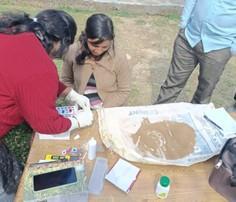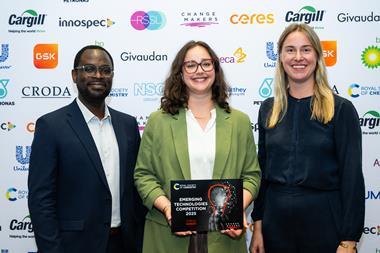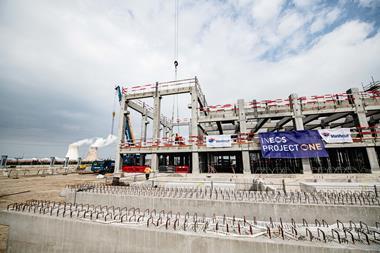India has progressed in adopting technologies and policies for climate-sustainable development, focusing on renewables, energy efficiency and electric vehicles. However, climate adaptation and resilience pose complex challenges. As efforts in adaptation and resilience intensify across the globe, India also aims to leverage its growing technology and innovation ecosystem to address these issues, recognising that clean technologies in adaptation efforts will support sustainable growth.
AGNIi Mission (set up under the aegis of the Office of the Principal Scientific Adviser to the Government of India executed in partnership with Invest India) has conceptualised and executed various climate adaptation projects for India’s Himalayan Region in collaboration with Uttarakhand State Council for Science and Technology (UCOST), Government of Uttarakhand.1-4 While the initiative focused on a specific region within the Indian Himalayan Region, it serves as a scalable model to propose new policies mechanisms for enabling better technology adoption for a robust and sustainable development.
Community-centric approach
Engaging with communities is of paramount importance and must be an integral part of any technology intervention initiative. As Nitin Maurya, head of the Dissemination and Social Diffusion Department at the National Innovation Foundation stated in a technical session organised by AGNli last year: ‘Climate change is a global phenomenon but it’s effects are felt mostly at local community level and hence the solutions have to be contextualised for perspective of the affected communities.’ At the outset, it is critical to identify precise problem areas and create a nuanced map of pain-points for the region through extensive community engagement. Further, it is essential to develop a clear understanding of operational intricacies such as local needs and conditions, and of user-personas that offer deep insights into the priorities, backgrounds and needs of decision-makers and technology users across multiple tiers, thereby increasing the likelihood of successful implementation.
The efficacy of technological interventions is contingent upon their adoption by local communities
For instance, due to the vagaries of climate change, growing traditional crops in the Indian Himalayan Region is no longer viable and hence there is a need for climate resistant varieties or for farmers to switch to growing crops or plants more suited to the climatic conditions. At the same time understanding the demographics of the region becomes crucial – in the mountain regions of India, men typically migrate to the plains for better career opportunities so communities in these regions are made up of mostly women and the elderly. Thus, convening women and their self-help groups along with elderly and local civil society organisations was crucial for success. This collective approach is important to capture the priorities and insights of diverse stakeholders to frame precise pain points and prioritise the most important problems to be solved.
It is imperative for any initiative to start with understanding the needs and motivations of different stakeholder groups, for the technology adoption facilitators to tailor their interventions more precisely, ensuring that the technology adoption process addresses the concerns and priorities of all parties.
Building technology stacks
The efficacy of technological interventions is contingent upon their adoption by local communities. The intervention needs complementary technologies to come together and work in tandem. In order to address the multifaceted challenges that affect myriad associated stakeholders, a comprehensive Technology Stack approach is needed. This concept requires that interventions not only exhibit technical proficiency but also align with local contextual dynamics and presents a multi-tiered approach carefully integrating traditional methods with advanced technologies. A technology stack approach moves beyond single-technology solutions to create synergistic combinations of complementary technologies, ranging from advanced solutions to frugal and incremental innovations.
| Preparation for cropping | Sowing | Crop care | Harvest | Post harvest | Market access and linkages | |
|---|---|---|---|---|---|---|
| Sensors | pH sensor - acidity/basicity of soil sample Optical transducers - N, P, K levels in soil DHT11 microclimate sensor - air and soil temperature, soil humidity |
Optimised fertilizer application Hyperlocal weather data collection Animal intrusion detection system |
UAV and drone-based field surveys UAS mounted sensing for soil and weather parameters IoT sensors for micro-area weather monitoring and alerting Animal intrusion detection system |
Animal intrusion detection system | Storage hotspot identification and forecast | Blockchain based supply chains Transport optimization via GPS-tagged elements to reduce transportation costs |
| AI | Credit risk assessment for non-traditional variety growers (crop insurance) Sowing recommender system: personalised recommendation systems |
Optimised sowing cycle AI based robots for automated and intelligent sowing Hyperlocal weather data analysis and prediction Drone based sowing |
Scouting, monitoring and weeding using farm robots & autonomous ground vehicles (AGVs) | Sorting using image recognition AI-enabled robots for harvesting and simultaneous assaying, grading and sorting to improve efficiency |
Image recognition for grading of produce | Demand forecasting Price forecasting Granular geo-mapping of agricultural commodition and demand pockets |
| Digital platforms | Language translation platforms to educate farmers, in their local language/dialect, on the adoption of right package of practices and inputs On-demand equipment rentals AI voice-bots for know-how sharing Vernacular weather and crisis advisories Online marketplace and e-commerce |
Vernacular advisory On-demand equipment rentals Online marketplace and e-commerce |
Vernacular advisory On-demand mobile storage-as-a-service model |
Produce pick-ups as a service | ||
| Mechanised equipment | Electric tractor, mini tractor, compact ploughing implements | Compact lightweight farm inputs delivery modules | Electric tractor, mini tractor, compact agri-implements | Loading trucks with dry ice bricks using CO2 cylinders [20kg CO2 -> 5 kg of dry ice] Storage for cold temperatures [0-5] (solar, electric) Humidity control, temperature control, ventilation control Thermal efficient biomass chullah Storage capacity Portability |
||
The idea is to collate the insights, information and data from all communities and associated actors and combine it with technology and sector expert’s inputs to build a simple grid of value chain within the existing domain and technology capabilities to address the challenges in each component of the value chain. This allows for a more holistic and effective implementation of such clean technologies, addressing the complex and interconnected nature of climate change challenges.
For example, farmers’ needs are not limited to farming problems. AI-powered facial recognition systems for cows that use muzzle patterns to identify individual animals, can link the animals to extensive databases of health, breeding and ownership records. Machine vision solutions can monitor bee behaviour and hive conditions that can classify bees entering and exiting the hive, record characteristics such as pollen carried, and analyse data to provide insights on forage availability, colony health and potential pest infestations. Even frugal technology solutions like solar-powered silk reeling machines for sericulture or active packaging sachets to extend the shelf life of fruits and vegetables are extremely important.
This holistic strategy aims to address livelihood resilience, optimise resource use and mitigate climate change impacts while fostering sustainable economic growth in the region.
Test-beds for technology demonstration and interaction
While pain points identification, expert consultations and technology stacks are crucial, a technology must ultimately be placed in the hands of the people who will use it. Everett Rogers, in his work Diffusion of Innovations emphasised that the perceived attributes of innovations influence their adoption rate.5 Demonstrating solutions in authentic on-ground settings is pivotal to their adoption and success.
Testbeds help demonstrate these key attributes: relative advantage, compatibility, complexity, trialability, and observability to decision-makers and end adopters. In practice, this goes beyond mere demonstration of a technology and incorporates an ‘adaptive testing’ approach where technologies are iteratively modified based on stakeholders’ feedback, ensuring that solutions are optimised for local conditions to enhance their chances of wide-scale adoption. This adaptive approach can allow innovators to refine and adjust technologies in response to the practical reality, creating a dynamic and responsive technology adoption environment.
Hands-on approach

One of the important factors at the heart of the initiative was selection of Champawat district in the state of Uttarakhand as a test-bed which served as a microcosm of the larger region. With its diverse topography ranging from the Terai lowlands to the high mountain ranges, it offered an ideal testbed for innovative solutions that could be scaled across the entire Himalayan belt.
During one such showcase, local women came forward to use the technologies being showcased – an Internet of Things enabled soil testing, shown here device being operated by one of the local woman from district Champawat.
The technology demonstrations organised by the AGNIi Mission revealed a heterogeneous adoption potential across the technological spectrum. This nuanced evaluation informed the development of tailored implementation strategies, addressing potential adoption barriers and optimising diffusion rates among diverse stakeholder groups. The AGNIi Mission’s initiative did eventually lead to the district-level administration creating a dedicated innovation fund to support procurement of select innovations like Internet of Things (IoT)-enabled soil testing and carbon detection kits amongst others. The collaborative spirit and technology orientation fostered by this initiative also led to other private efforts, one of which was the creation of the Himalayan Academy of Science & Technology (HAST). This is a network of academicians, researchers and innovators with a deep interest in the Himalayan ecosystem who contribute towards multi-disciplinary research and development in the region.
Implementing climate adaptation technologies is most effective when it involves collaborative ecosystems rather than isolated solutions. Direct interactions between stakeholders and innovators, coupled with on-site technology demonstrations, significantly mitigate adoption barriers. Establishing sub-regional financing mechanisms at block and district levels is crucial for piloting and scaling localised technological solutions. The initiative’s findings suggest that community-engaged test beds, involving both public and private sectors, could serve as valuable policy design elements. These test beds facilitate hands-on technology engagement, fostering trust and understanding among stakeholders and innovators. Moving forward, it is imperative to integrate technology adoption interventions into comprehensive climate resilience strategies. By leveraging local funding pools, collaborative research networks, and interactive technology showcases—while maintaining adaptability—policymakers can craft more effective and sustainable climate technology adoption interventions.
References
5 E M Rogers, Diffusion of Innovations, 1962, Free Press, New York.


Topics
Chemistry will support India’s sustainability ambitions
- 1
- 2
- 3
- 4
- 5
- 6
- 7
 Currently reading
Currently readingBuilding community-centric technology from the ground up
- 8
- 9
- 10
- 11
- 12

























No comments yet